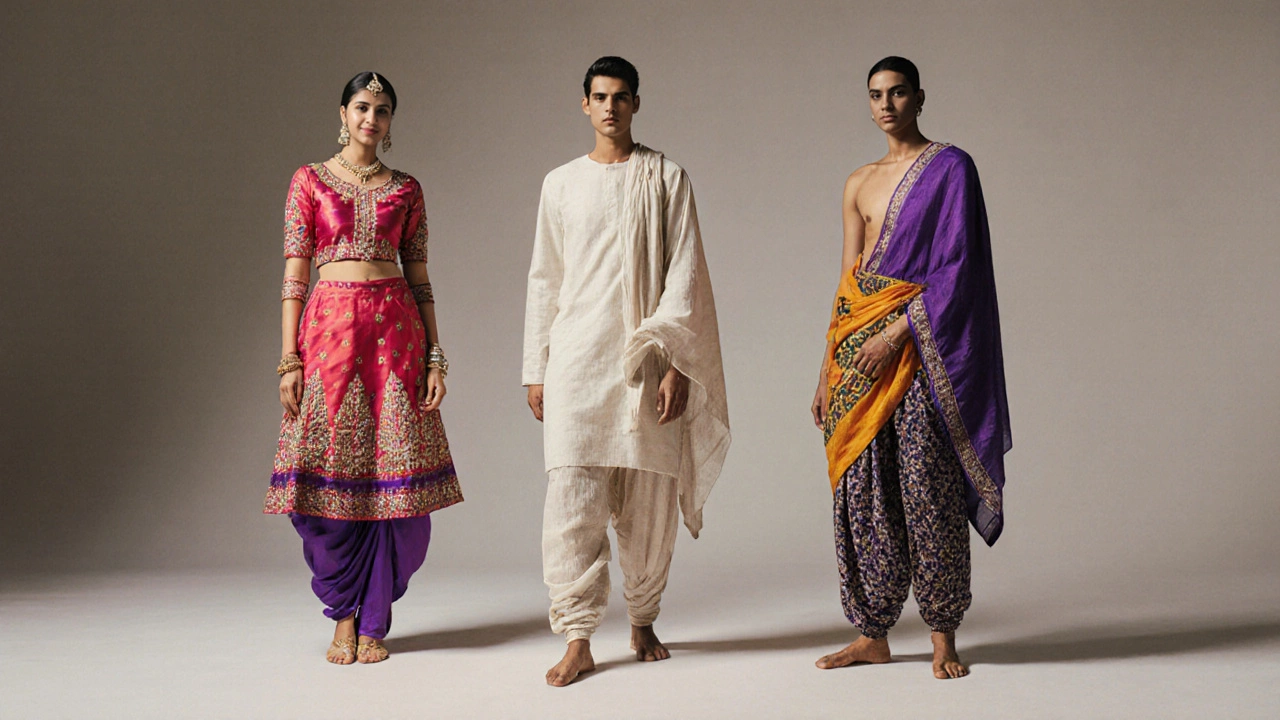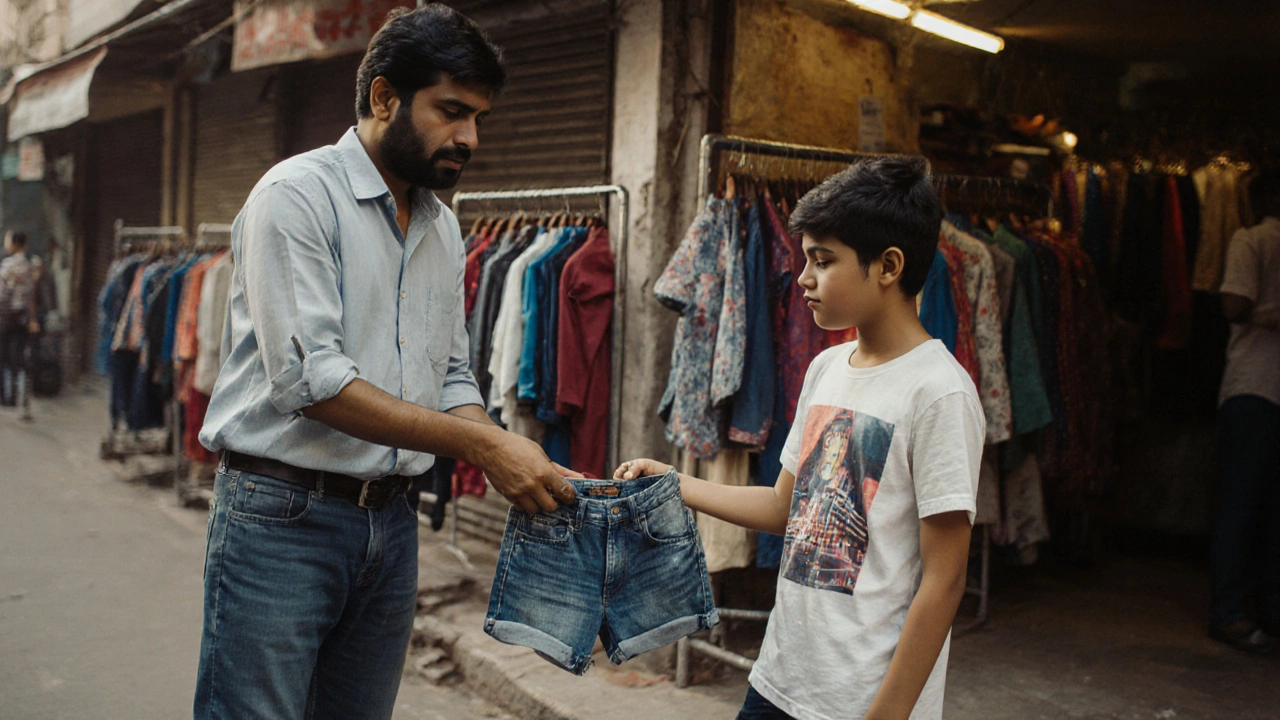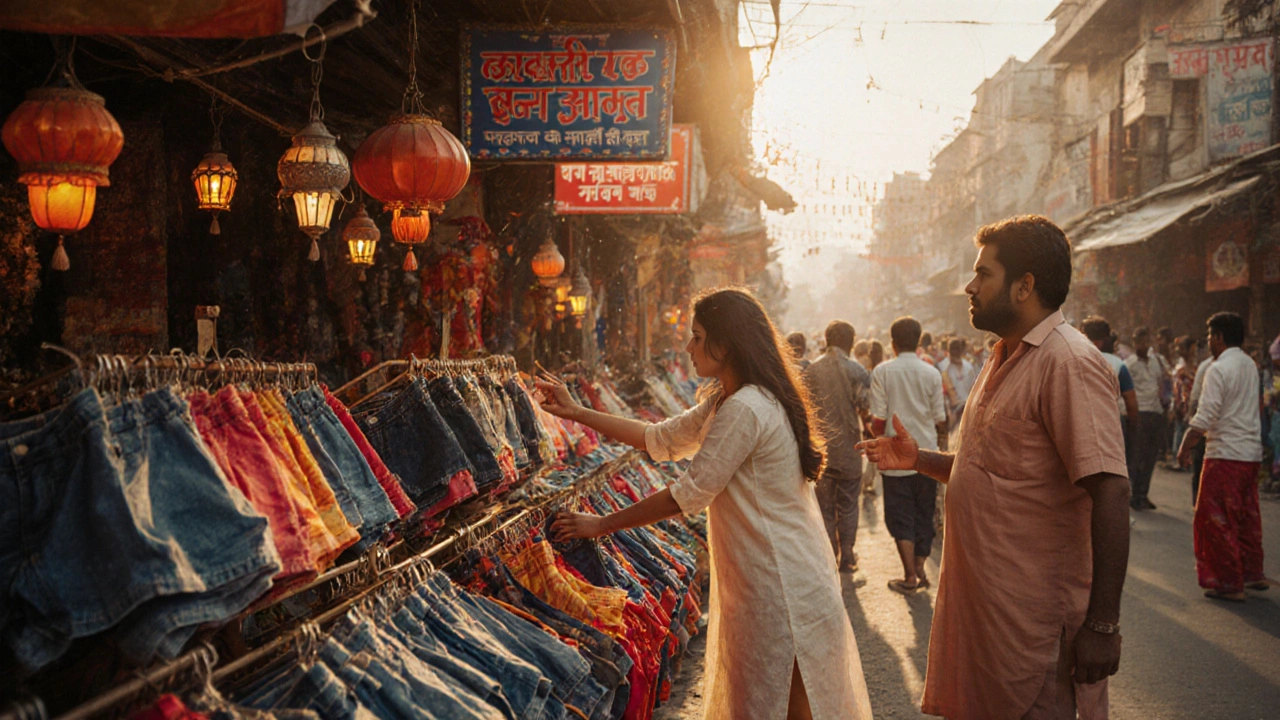Indian Shorts Translator & Guide
Language Translation
See how "shorts" is expressed in major Indian languages.
Traditional Alternatives
Learn about traditional Indian garments that function like shorts.
| Language | Translation | Notes |
|---|---|---|
| English | Shorts | Loanword used as-is |
| Hindi | शॉर्ट पैंट (shorṭ pāinṭ) | Literally means "short pant" |
| Bengali | শর্টস (shorts) | English word in Bengali script |
| Telugu | షార్ట్ ప్యాంట్ (shārt pyāṇṭ) | Transliteration of English |
| Kannada | ಶಾರ್ಟ್ ಪ್ಯಾಂಟ್ (shārt pyānṭ) | Transliteration of English |
| Malayalam | ഷോർട്ട് പാന്റ് (shōrṭ pāṇṭ) | Transliteration of English |
| Punjabi | ਸ਼ਾਰਟਸ (shārṭs) | English word in Gurmukhi script |
| Tamil | ஷார்ட் (shāṟṭ) | English word transliterated |
| Garment | Typical Length | Material | Occasion |
|---|---|---|---|
| Lungi | Waist-to-ankle (wrapped, can be shortened) | Cotton, silk, or rayon | Daily wear in South India & Bangladesh |
| Dhoti | Mid-calf to ankle (often folded up) | Cotton or khadi | Religious ceremonies, weddings |
| Salwar | Below knee, loose-fit | Cotton, silk blends | Everyday & festive wear for women |
| Churidar | Knee-to-ankle, fitted | Stretch cotton, silk | Formal wear, dance costumes |
| Lehenga Shorts | Above knee, flared | Silk, georgette, embroidered | Modern bridal & party wear |
| Bermuda Shorts | Mid-thigh to just above knee | Cotton, linen, denim | Casual, school uniforms |
When to Wear Modern Shorts vs. Traditional Options
- Urban Casual: Denim or cotton shorts are perfect for coffee runs, college campuses, and weekend markets.
- Beach or Pool: Quick-dry fabrics and swim-trunks are the go-to. You’ll still hear people call them "shorts" in English.
- Festivals & Weddings: Opt for a Salwar or Lehenga Shorts if you want a short silhouette that respects tradition.
- Religious Ceremonies: A Dhoti or Lungi is the safe bet for men, especially in rural settings.
Quick Tip: If you're unsure, ask a local vendor: "Shorts chahiye?" (Do you need shorts?) People will instantly understand.
Ever walked into a shop in Delhi and wondered what locals call those casual, knee‑length pants you see on the streets? You’re not alone. While most of us just say “shorts,” the phrase takes on a few different flavors across India’s many languages and wardrobes. Below you’ll get the everyday names, the Hindi and regional translations, and a quick look at the traditional garments that serve a similar purpose.
What “shorts” actually are in India
In modern Indian cities, Indian shorts are simply the Western‑style short trousers that end above the knee. They’re popular for school uniforms, gym wear, beach trips, and casual outings. You’ll spot them in cotton, denim, and performance fabrics, just like anywhere else in the world.
Unlike many traditional outfits that involve wraps or long drapes, shorts are a relatively new addition to the Indian closet, gaining traction after the 1990s when global fashion flooded the market.
Everyday names in the most‑spoken Indian languages
When you need to ask for a pair at a market or describe them to a friend, here’s how the term translates across the linguistic landscape:
- Shorts - English loanword used as‑is in everyday Hindi, Marathi, Gujarati, and Punjabi conversations
- Hindi: शॉर्ट पैंट (shorṭ pāinṭ) - literally “short pant”
- Bengali: শর্টস (shorts) - English word written in Bengali script
- Telugu: షార్ట్ ప్యాంట్ (shārt pyāṇṭ)
- Kannada: ಶಾರ್ಟ್ ಪ್ಯಾಂಟ್ (shārt pyānṭ)
- Malayalam: ഷോർട്ട് പാന്റ് (shōrṭ pāṇṭ)
- Punjabi (Gurmukhi): ਸ਼ਾਰਟਸ (shārṭs)
- Tamil: ஷார்ட் (shāṟṭ) - the English term transliterated
In most regions, people just default to the English “shorts” because it’s shorter than any literal translation. You’ll rarely hear a native‑crafted word for the garment.

Traditional Indian garments that act like shorts
While the Western cut dominates today’s casual wear, India has a rich set of traditional lower‑body pieces that stop at or just above the knee. Many of these are still worn for festivals, weddings, or regional daily life.
| Garment | Typical Length | Material | Occasion |
|---|---|---|---|
| Lungi | Waist‑to‑ankle (wrapped, can be shortened) | Cotton, silk, or rayon | Daily wear in South India & Bangladesh |
| Dhoti | Mid‑calf to ankle (often folded up) | Cotton or khadi | Religious ceremonies, weddings |
| Salwar | Below knee, loose‑fit | Cotton, silk blends | Everyday & festive wear for women |
| Churidar | Knee‑to‑ankle, fitted | Stretch cotton, silk | Formal wear, dance costumes |
| Lehenga Shorts | Above knee, flared | Silk, georgette, embroidered | Modern bridal & party wear |
| Bermuda Shorts | Mid‑thigh to just above knee | Cotton, linen, denim | Casual, school uniforms |
When to wear modern shorts vs. traditional options
- Urban casual: Denim or cotton shorts are perfect for coffee runs, college campuses, and weekend markets. Pair them with a tee, polo, or kurta‑style top for a relaxed vibe.
- Beach or pool: Quick‑dry fabrics and swim‑shorts (known locally as "swim trunks") are the go‑to. You’ll still hear people call them "shorts" in English, even in Tamil Nadu or Kerala.
- Festivals & weddings: Opt for a Salwar or Lehenga Shorts if you want a short silhouette that respects tradition.
- Religious ceremonies: A Dhoti or Lungi is the safe bet for men, especially in rural settings.
Choosing the right style is mostly about context. If you’re unsure, ask a local vendor: “Shorts chahiye?” (Do you need shorts?) People will instantly understand.
Where to buy Indian shorts and what to look for
Modern retailers-both online and brick‑and‑mortars-stock a huge range. Here’s a quick checklist to keep you from ending up with ill‑fitting or low‑quality pants:
- Fabric: Cotton and blends are breathable for India’s heat. For sports, look for moisture‑wicking polyester.
- Rise: Mid‑rise works for most body types. Low‑rise styles are popular among teens but can be uncomfortable in public transport.
- Length: Aim for the point where your thumb touches the knee when you stand straight-this is the sweet spot for both comfort and modesty.
- Fit: Try both relaxed and slim cuts. Slim cuts look sharper but may chafe in humid climates.
- Brand credibility: Indian brands like **Mast & Harbour**, **Adidas India**, and **H&M India** often run seasonal sales. For local hand‑loom shorts, look for the Khadi label.
Popular marketplaces include Myntra, Flipkart, and Amazon India. Physical markets-such as Sarojini Nagar (Delhi) or Commercial Street (Bangalore)-offer great bargains, especially if you can negotiate the price.

Common misconceptions about Indian shorts
- "Are shorts allowed in temples?" Most temples require modest dress-shorts above the knee are generally discouraged. Opt for full‑length pants or a Kurta with loose trousers.
- "Do Indian languages have a unique word for shorts?" No single native term exists; the English loanword dominates everyday speech.
- "Can I wear denim shorts in every Indian city?" Yes, but in very conservative towns (e.g., parts of Rajasthan), you might attract unwanted attention. Pair with a long‑sleeve shirt or carry a lightweight scarf.
Quick cheat‑sheet for asking about shorts in India
- Hindi: “Mujhe ekshorts chahiye.” (I need a pair of shorts.)
- Telugu: “Naaku okashorts kavali.”
- Tamil: “Enakku orushorts venum.”
- Gujarati: “Mane ekshorts joie.”
- Marathi: “Mala ekshorts pahije.”
Just smile, point to the style you like, and you’ll be set.
Frequently Asked Questions
What do Indians call shorts in everyday conversation?
Most people simply say “shorts.” In Hindi you’ll hear “shorṭ pant” or “shorts,” and the same English word is written in regional scripts.
Are there any traditional Indian garments that resemble shorts?
Yes. The Salwar, Lehenga Shorts, and modern Bermuda Shorts provide a short silhouette while staying rooted in Indian fashion.
Can I wear shorts to a temple or religious ceremony?
Generally no. Most temples ask visitors to wear modest clothing-full‑length pants or a Kurta with loose trousers is the safe choice.
Where should I shop for quality shorts in India?
Online platforms like Myntra and Flipkart offer a wide range, while street markets such as Sarojini Nagar (Delhi) or Commercial Street (Bangalore) provide budget‑friendly options. Look for the Khadi label if you prefer hand‑loom fabrics.
Do Indian languages have a unique word for “shorts”?
No single native term exists. The English word “shorts” has been borrowed across the country, often written in the local script.
